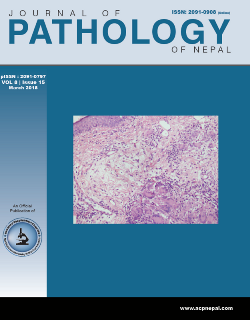Histopathological audit of renal biopsy in Nepalese children: two center experience
DOI:
https://doi.org/10.3126/jpn.v8i1.19443Keywords:
Hematuria, Histopathology, IgA nephropathy, Kidney, Nephrotic, RenalAbstract
Background: Renal biopsy is an invaluable tool which provides histopathological description of renal disease in terms of severity of lesion and helps in formulating the long term plan. However such studies with histopathological description of renal biopsy among Nepalese children are scarce.
Material and Methods: This was a retrospective study conducted among all children aged less than 18 years who underwent renal biopsy at two tertiary centers in Nepal between July 2015 and December 2017.
Results: All 72 renal biopsies were done with Bard 18G spring loaded gun. Nephrotic syndrome and mixed nephritic-nephrotic features were the commonest indications for renal biopsy. IgA nephropathy was the most frequent histopathological diagnosis (20.8%) which was mainly observed in children of age group 11-18 years followed by minimal change disease (16.7%) and diffuse proliferative glomerulonephritis (16.7%). Majority of children with recurrent gross hematuria (6/7) or mixed nephritic-nephrotic features (6/8) had IgA nephropathy. Focal segmental glomerulosclerosis (6/8) was commonest in children with steroid resistant nephrotic syndrome and nephrotic syndrome with atypical features. Majority of children (10/12) with diffuse proliferative glomerulonephritis had features of poststreptococcal glomerulonephritis and 6/12 had crescents in glomeruli. Lupus nephritis (13.9%) was the commonest secondary cause of glomerular pathology and was observed predominantly in 11-18 years age.
Conclusion: Renal biopsy is safe and not associated with clinically significant complications. Nephrotic syndrome was the commonest indication for renal biopsy and minimal change disease predominated. IgA nephropathy was the commonest histological diagnosis overall, as well as in children who presented with recurrent gross hematuria or mixed nephritic-nephrotic features.
Downloads
Downloads
Published
How to Cite
Issue
Section
License
This license enables reusers to distribute, remix, adapt, and build upon the material in any medium or format, so long as attribution is given to the creator. The license allows for commercial use.




